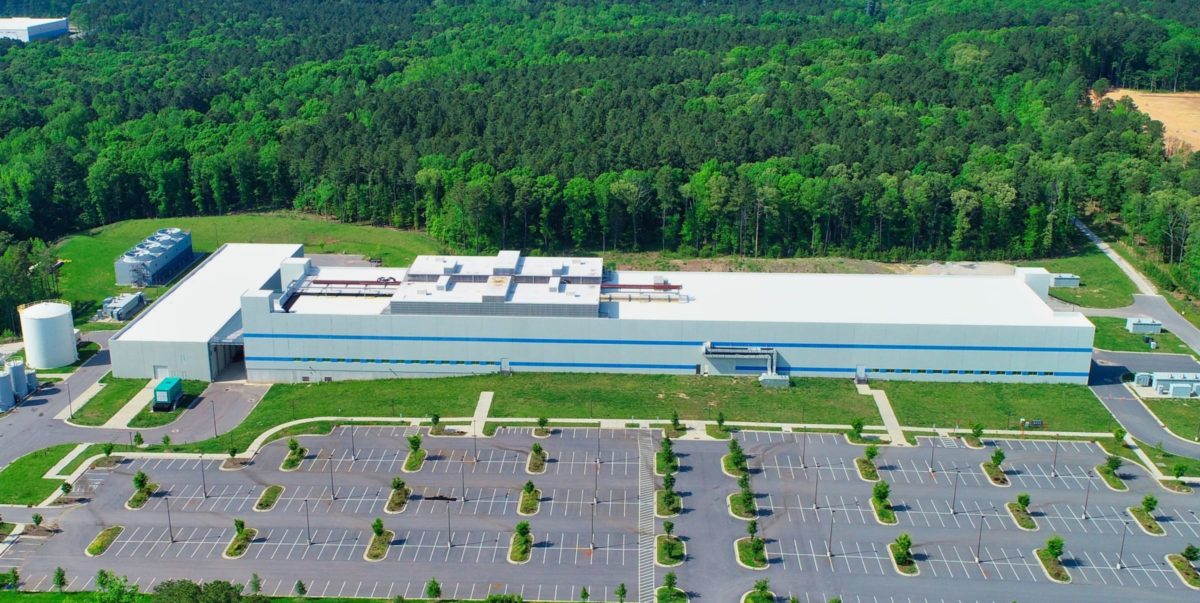There are not a lot of big step-changes in solar technology, but silicon carbide (SiC) could be one of these. The material holds promise for inverters, by allowing for smaller chips with greater power density as well offering a greater switching frequency, meaning fewer of the “passive elements” that make inverters big, bulky and more expensive.
And last week silicon carbide got a big boost when the company that pioneered industrial production of SiC announced plans to invest up to $1 billion to build an automated silicon carbide fab and “materials mega-factory” at its headquarters in Durham, North Carolina.
Cree says that the new factory will enable an increase up to 30x in its capacity to make silicon carbide by the time it is online in 2024, versus the company’s production in Q1 of 2017. It could also speed the move to 200 mm wafers, up from 150 mm, although initially the factory will put out 150 mm wafers.
Specifically, Cree plans to invest $450 million in its North Fab, $450 million in the adjacent megafactory, and $100 million in other investments related to the business. It also notes that by using mostly refurbished tools, it will be able to build the new fab at 1/3 the cost of a factory using entirely new tools.
EVs, 5G networks and inverters
It’s not clear exactly which markets Cree is targeting with its new production, and inverters are not the only application which would benefit from SiC. The company mentions solutions to extend the range and reduce charge times for EVs, as well as supporting the rollout of 5G networks globally.
Simon Price, the head of research at Exawatt, says that while inverters were the main market for SiC semiconductors a year or two ago, that this how now switched to EVs, with the Tesla Model 3 driving demand.
“This is in part due to the far higher overall material requirement (an EV is a device hog) but also because the value proposition for SiC is so strong in EV applications, where size, weight, performance and conversion efficiency are all critical,” Price told pv magazine.
Price estimates that SiC components can add 5-10% to the range of an EV. “As SiC prices fall, we expect SiC to gradually become the dominant semiconductor material used in EV powertrains,” states Price.
He also says that while inverters could “absolutely” be a market for the output of this new factory, that the EV market is currently higher value. However, if SiC for inverters ended up benefitting from the technology development and economies of scale driven by EV applications, this would not be the first time that EVs have accelerated the adoption of a material beneficial to the solar industry. Both cost reductions and technology improvements in lithium-ion batteries have also been driven by the growing EV industry.
A U.S. materials industry?
And while lithium, cobalt, graphite and other materials for the EV market have been dominated by China, SiC is a material whose production is booming in the United States.
Cree’s move to scale its SiC production follows on the launch of an SiC fab by GT Advanced Technologies in New Hampshire last year, and Danfoss has also built a factory in collaboration with State University of New York (SUNY) – although the last news we heard about this collaboration was GE pulling out in late 2017.
However, unlike GT which so far only makes the material, and Danfoss which only makes electronic components using SiC material, Cree makes both SiC material and components.
Simon Price of Exawatt says that due to Cree, the United States is a leader in SiC production, although European and Japanese companies are also active. “China is working aggressively to grow SiC material capacity, but is currently further behind technologically,” notes Price.
And the larger market is booming. The problem so far with SiC appears to be largely that supply has not been able to keep up with demand, due to the difficulty in fabricating the material. But with technology improving and the EV market starting to take off, Price says this is driving the scale of output.
This content is protected by copyright and may not be reused. If you want to cooperate with us and would like to reuse some of our content, please contact: editors@pv-magazine.com.









By submitting this form you agree to pv magazine using your data for the purposes of publishing your comment.
Your personal data will only be disclosed or otherwise transmitted to third parties for the purposes of spam filtering or if this is necessary for technical maintenance of the website. Any other transfer to third parties will not take place unless this is justified on the basis of applicable data protection regulations or if pv magazine is legally obliged to do so.
You may revoke this consent at any time with effect for the future, in which case your personal data will be deleted immediately. Otherwise, your data will be deleted if pv magazine has processed your request or the purpose of data storage is fulfilled.
Further information on data privacy can be found in our Data Protection Policy.